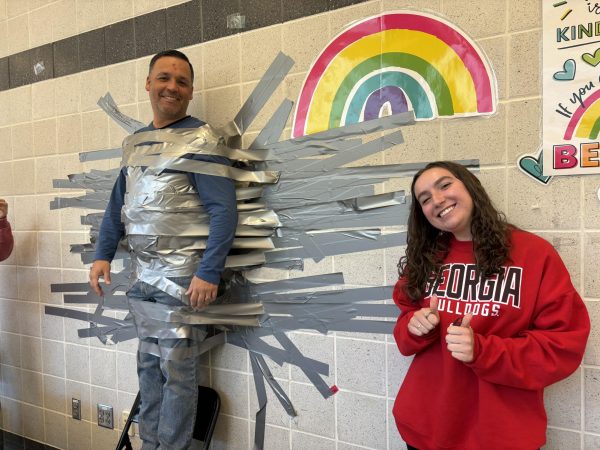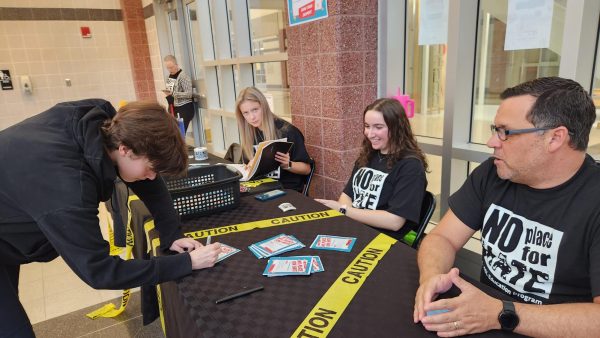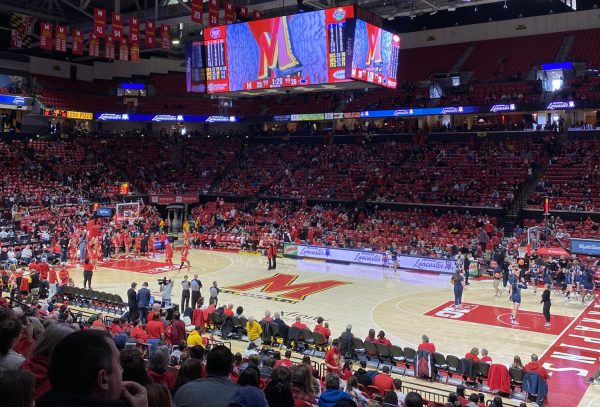Life after injury: What is the next step after your dreams don’t come true?

Alyse Montgomery completes her balance beam routine at practice.
March 11, 2016
Imagine this. Ever since you were little, you’ve dreamed of being a professional athlete. After all the years of hard work, blood, sweat, and tears, you’ve finally made it. You step out on the field and within a split second, your whole career is over.
One blow to the knee. One tackle. It’s all over. What do you do next?
For me, it was one wrong jump on beam. After the injury that ended my time as a gymnast, I had a lot more to deal with than just the physical aspect. I had to wrap my head around the idea I would no longer be able to compete in the sport I loved. What would life be without gymnastics? Today, I’m two years into my recovery with surgery on the horizon.
Some of the world’s most renowned athletes are victims of career ending injuries. Former Olympic gold medalist, gymnast Shawn Johnson was someone I had looked up to my whole life. Johnson’s career came to an end, due to a knee injury in 2010. Ironically, Johnson did not receive her career ending injury during the sport that made her world renowned, but instead during a pastime–skiing. Johnson was more determined than ever to make the 2012 Olympic gymnastics team after tearing her ACL, MCL, meniscus, and hamstring during the 2010 skiing accident. However, her knee had different ideas.
Unfortunately, Johnson was forced to retire from the sport of gymnastics entirely June 3, 2012 after a proud attempt at a comeback. Even before her retirement, Johnson possessed an impressive list of achievements, already including four Olympic medals, the prestigious Mirror Ball Trophy earned on ABC’s 8th season of “Dancing with the Stars”, being named the 79th Amateur Athletic Union (AAU) Sullivan Award recipient, and a published book, Olympic Champion-Stories Behind the Smile.
After retirement, Johnson was devastated and lost without gymnastics, but quickly rallied, adding to her list of accomplishments. Focusing her time on a new bestselling book, Winning Balance: What I’ve Learned So Far About Love, Faith and Living Your Dreams, co-founding TheBodyDepartment.com, advocating health and wellness, and becoming engaged to long time boyfriend, Andrew East are only a few ways Johnson has busied herself since retirement. Although Johnson no longer competes in the sport of gymnastics, it is still a strong constant in her life.
If I’m unable to one day compete in college, I hope to adopt Johnson’s attitude and keep moving forward.
Like Johnson, New England Patriot’s wide receiver, Darryl Stingley underwent a career ending injury. Darryl Stingley’s season came to an end before it even began during a 1978 preseason game against the Oakland Raiders. Despite the incomplete throw to Stingley by quarterback Steve Grogan, Oakland Raiders safety, Jack Tatum, plowed into Stingley, head-on. That one hit changed Stingley’s life. The hit resulted in two broken vertebrae, paralyzing Stingley from the chest down.
From there on out, Stingley spent the rest of his life in a wheelchair. Unfortunately, due to NFL rules at the time, Tatum’s hit was deemed legal. A flag wasn’t even thrown.
Regardless of the negative events of that night, Stingley managed to make something positive from the situation. In 1992, Stingley earned his bachelor’s degree in physical education from Purdue University. At a later date, Stingley served as Executive Director of Player Personnel for the Patriots, as well as co-authoring a 1983 memoir, Happy to Be Alive with the help of Mark Mulvoy. With the help of his son, Derek Stingley (age 7 at the time of the accident), the Darryl Stingley Youth Foundation was created as a non-profit agency in 1993, whose mission is to help the troubled youth of west Chicago. Unfortunately, Stingley died on April 5, 2007 from pneumonia complicated by his paralysis.
Today, Stingley is not remembered for the debilitating injury he endured, but for the gracious manner in which he carried himself after the 1978 injury.
Unlike the previous athletes mentioned, high school athletes don’t yet have careers in athletics. However, career ending injuries can still strongly affect student athletes. High school is a time when college scouts begin recruiting young athletes to contribute to their sports teams. Offers student athletes receive can often influence where the student chooses to go to college.
Remembering back to my own personal experience, I had hoped to pursue my career as a competitive gymnast and one day compete in college. Now I have had to learn to refocus my attention on a new sport, track, and other activities especially with college in the near future, rather than dwelling on a situation I can no longer change.
When a student athlete undergoes a career ending injury, these opportunities for recruitment in that specific sport have gone out the window, affecting the student’s overall future. All of this happening at once is overwhelming. What route do you take once you can no longer continue the sport you were once passionate about? Do you quit sports completely, find a new sport to invest your time in if possible, or engross yourself in activities not involving sports?
Current Class of 2017 student, Liz Hovis, had to make a lifestyle change after tearing her rotator cuff muscle in her shoulder during swim practice. After a life of swimming, 13-year-old Hovis says, “When I found out I couldn’t swim, I was crushed. I felt like I wasn’t good at anything in life, almost useless. Swimming was all I had ever done and all I ever knew and I was lost without it. I wasn’t sure what to do with my life when it ended because it was my whole life.”
After completing physical therapy and trying dance, Hovis recognized her need for a sport similar to swimming where she could race. That’s when she began running track, her current sport. Rather than giving up entirely, Hovis says, “I got over the initial shock of not being able to swim by throwing myself in another sport and getting involved. I just focused on something else until I discovered something I liked to do.”
Despite not being able to see where her potential would take her in swimming, Hovis says she does not regret having to quit swim after her injury, as track has had such a positive impact on her life. “With track, I’ve met some new wonderful people and made new lifetimes friends. It’s also a sport I can do for the rest of my life and forever be healthy.”
To overcome the shock of having to quit gymnastics from my own personal injury, I invested my time into track and began coaching gymnastics. In this way I, too, was able to refocus my attention in a similar, competitive atmosphere, as well as staying involved in the sport of gymnastics.
Overall, career ending injuries have proven to alter athlete’s lives tremendously. However, career ending injuries are not necessarily the end of the world or the end of your future. By trying different things and leaving yourself open to new opportunities, you may find something you are equally passionate about. Always keep your options open and your head held high, as you never know what your future has in store.












